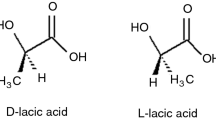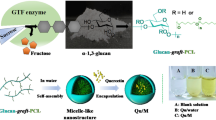Abstract
The aim of this work was to functionalize cotton gauzes with cyclodextrins in order to endow them with the ability to elute antimicrobial agents and to prevent infections. Gauzes were modified according to a two-steps approach: (1) pre-irradiation of the gauzes (Gammabeam) to graft glycidyl methacrylate (GMA), and (2) covalent binding of cyclodextrins (CDs) to the GMA-grafted gauzes. First the dependence of GMA grafting yield on the radiation dose (from 1 to 20 kGy) and the time of reaction was evaluated in detail. Anchorage of β-cyclodextrin (β-CD) and hydroxypropyl-β-cyclodextrin (HP-β-CD) was confirmed by FTIR, TGA, and 3-methylbenzoic acid sorption. Differently from pristine gauzes, CD-functionalized GMA-grafted gauzes were able to load an anionic antibiotic drug, specifically nalidixic acid, and to sustain the release for 6 h. Drug-loaded gauzes were tested in vitro against E. coli and the results prove the suitability of the functionalization approach to efficiently inhibit the growth of this microorganism.










Similar content being viewed by others
References
Abdel-Halim ES, Fouda MMG, Hamdy L, Abdel-Modhy FA, El-Sawy SM (2010) Incorporation of chlorohexidin diacetate into cotton fabrics grafted with glycidyl methacrylate and cyclodextrin. Carbohydr Polym 79:47–53
Alvarez-Lorenzo C, Bucio E, Burillo G, Concheiro A (2010) Medical devices modified at the surface by g-ray grafting for drug loading and delivery. Expert Opin Drug Del 7:173–185
Arseneau DF (1971) Competitive reaction in the thermal decomposition of cellulose. Can J Chem 49:632–638
Blackburn RS, Harvey A, Kettle LL, Manian AP, Payne JD, Russell SJ (2007) Sorption of chlorhexidine on cellulose: mechanism of binding and molecular recognition. J Phys Chem B 111:8775–8784
Bolton LL, Johnson CL, Van Rijswijk L (1991) Occlusive dressings: therapeutic agents and effects on drug delivery. Clin Dermatol 9:573–583
Brandt C, Hott U, Sohr D, Daschner F, Gastmeier P, Rüden H (2008) Operating room ventilation with laminar airflow shows no protective effect on the surgical site infection rate in orthopedic and abdominal surgery. Ann Surg 248:695–700
Buschmann HJ, Denter U, Knittel D, Schollmeyer E (1998) The use of cyclodextrins in textiles processes—an overview. J Text Inst 89:554–561
Chen-Yu JH, Eberhardt DM, Kincade DH (2007) Antibacterial and laundering properties of AMS and PHMP as finishing agents on fabric for health care workers’ uniforms. Cloth Text Res J 25:258–272
Contreras-García A, Bucio E, Concheiro A, Alvarez-Lorenzo C (2010) Polypropylene grafted with NIPAAm and APMA for creating hemocompatible surfaces that load/elute nalidixic acid. React Funct Polym 70:836–842
Contreras-García A, Bucio E, Brackman G, Coenye T, Concheiro A, Alvarez-Lorenzo C (2011) Biofilm inhibition and drug-eluting properties of novel DMAEMA-modified polyethylene and silicone rubber surfaces. Biofouling 27:123–135
Dastjerdi R, Montazer M (2010) A review on the application of inorganic nanostructured materials in the modification of textiles: focus on anti-microbial properties. Colloids Surf B 79:5–18
Desmet G, Takács E, Wojnárovits L, Borsa J (2011) Cellulose functionalization via high-energy irradiation-initiated grafting of glycidyl methacrylate and cyclodextrin immobilization. Radiat Phys Chem 80:1358–1362
Ershov BG (1998) Radiation-chemical degradation of cellulose and other saccharides. Russ Chem Rev 67:315–334
Fundueanu G, Constantin M, Mihai D, Bortolotti F, Cortesi R, Ascenzi P, Menegatti E (2003) Pullulan-cyclodextrin microspheres. A chromatographic approach for the evaluation of the drug-cyclodextrin interactions and the determination of the drug release profiles. J Chromatogr B 791:407–419
Gao Y, Cranston R (2008) Recent advances in antibacterial treatments of textile. Text Res J 78:60–72
Gopalakrishnan D, Aswini RK (2012) Antimicrobial finishes. http://www.fibre2fashion.com/industry-article/pdffiles/antimicrobial-finishes.pdf. Accessed Aug 2012
Gorensek M, Recelj P (2007) Nanosilver functionalized cotton fabric. Text Res J 77:138–141
Gouda M, Ibrahim NA (2008) New approach for imparting antibacterial function to cotton fabric. J Ind Text 37:327–339
Grover G, Kini SG (2006) Synthesis and evaluation of new quinazolone derivatives of nalidixic acid as potential antibacterial and antifungal agents. Eur J Med Chem 41:256–262
Hirotsu T (2006) Plasma graft polymerization of glycidyl methacrylate and cyclodextrin immobilization. Thin Solid Films 506:173–175
Hosoya T, Kawamoto H, Saka S (2007) Cellulos-hemicellulose and celluloselignin interactions in wood pyrolysis at gasification temperature. J Anal Appl Pyrol 80:118–125
Ibrahim NA, Gouda M, El-shafei AM, Abdel-Fatah OM (2007) Antimicrobial activity of cotton fabrics containing immobilized enzymes. J Appl Polym Sci 104:1754–1761
Ibrahim NA, Eid BM, Hashem MM, Refai R, El-Hossamy M (2010) Smart options for functional finishing of linen-containing fabrics. J Ind Text 39:233–265
Ibrahim NA, Eid BM, El-Batal H (2012) A novel approach for adding smart functionalities to celluosic fabrics. Carbohydr Polym 87:744–751
Le Thuaut P, Martel B, Crini G, Maschke U, Coqueret X, Morcellet M (2000) Grafting of cyclodextrins onto polypropylene nonwoven fabrics for the manufacture of reactive filters. I. Synthesis parameters. J Appl Polym Sci 77:2118–2125
Lee S, Lee MY, Park WH (2002) Thermal stabilization of poly(3-hydroxybutyrate) by poly(glycidyl methacrylate). J Appl Polym 83:2945–2952
Lina S, Hsua S, Sheub M (2010) Curve-fitting FTIR studies of loratadine/hydroxypropyl-β-cyclodextrin inclusion complex induced by co-grinding process. J Pharm Biomed 53:799–803
Loftsson T, Hreinssdóttir D, Másson M (2005) Evaluation of cyclodextrin solubilization of drugs. Int J Pharm 302:18–28
Martel B, Weltrowski M, Ruffin D, Morcellet M (2002) Polycarboxylic acids as crosslinking agents for grafting cyclodextrins onto cotton and wool fabrics: study of the process parameters. J Appl Polym Sci 83:1449–1456
Martínez-Martínez L, Pascual A, Jacoby GA (1998) Quinolone resistance from a transferable plasmid. Lancet 351:797–799
Mouës CM, van den Bemd GJCM, Heule F, Hovius SER (2007) Comparing conventional gauze therapy to vacuum-assisted closure wound therapy: a prospective randomised trial. J Plast Reconstr Aesthet Surg 60:672–681
Nava-Ortiz CAB, Alvarez-Lorenzo C, Bucio E, Concheiro A, Burillo G (2009a) Cyclodextrin-functionalized polyethylene and polypropylene as biocompatible materials for diclofenac delivery. Int J Pharm 382:183–191
Nava-Ortiz CAB, Burillo G, Bucio E, Alvarez-Lorenzo C (2009b) Modification of polyethylene films by radiation grafting of glycidyl methacrylate and immobilization of β-cyclodextrin. Radiat Phys Chem 78:19–24
Nava-Ortiz CAB, Burillo G, Concheiro A, Bucio E, Matthijs N, Nelis H, Coenye T, Alvarez-Lorenzo C (2010) Cyclodextrin-functionalized biomaterials loaded with miconazole prevent Candida albicans biofilm formation in vitro. Acta Biomater 6:1398–1404
Perez D, Bramkamp M, Exe C, von Ruden C, Ziegler A (2010) Modern wound care for the poor: a randomized clinical trial comparing the vacuum system with conventional saline-soaked gauze dressings. Am J Surg 199:14–20
Qian L, Guan Y, Ziaee Z, He B, Zheng A, Xiao H (2009) Rendering cellulose fibers antimicrobial using cationic β-cyclodextrin-based polymer included with antibiotics. Cellulose 16:309–317
Ren X, Kou L, Liang J, Worley SD, Tzou Y-M, Huang TS (2008) Antimicrobial efficacy and light stability of N-halamine siloxanes bound to cotton. Cellulose 15:593–598
Rosa dos Santos JF, Couceiro R, Concheiro A, Torres-Labandeira JJ, Alvarez-Lorenzo C (2008) Poly(hydroxyethyl methacrylate-co-methacrylated-β-cyclodextrin) hydrogels: synthesis, cytocompatibility, mechanical properties and drug loading/release properties. Acta Biomater 4:745–755
Rosa dos Santos JF, Alvarez-Lorenzo C, Silva M, Balsa L, Couceiro J, Torres-Labandeira JJ, Concheiro A (2009) Soft contact lenses functionalized with pendant cyclodextrins for controlled drug delivery. Biomaterials 30:1348–1355
Scott CP, Higham PA (2003) Antibiotic bone cement for the treatment of pseudomonas aeruginosa in joint arthroplasty: comparison of tobramycin and gentamicin-loaded cements. J Biomed Mater Res B 64:94–98
Sekine A, Seko N, Tamada M, Suzuki Y (2010) Biodegradable metal adsorbent synthesized by graft polymerization onto nonwoven cotton fabric. Radiat Phys Chem 79:16–21
Shehatta IS, Ibrahim MS, Sultan MR (2002) The antimicrobial nalidixic acid as a probe for molecular recognition of α- and β-cyclodextrins. Can J Chem 80:1313–1320
Shen DK, Gua S, Bridgwater AV (2010) The thermal performance of the polysaccharides extracted from hardwood: cellulose and hemicellulose. Carbohydr Polym 83:39–45
Shinohara T, Yamashitac Y, Satoh K, Mikami K, Yamauchi Y, Hoshino S, Noritomi A, Maekawa T (2008) Prospective evaluation of occlusive hydrocolloid dressing versus conventional gauze dressing regarding the healing effect after abdominal operations: randomized controlled trial. Asian J Surg 31:1–5
Szejtli J (1998) Introduction and general overview of cyclodextrin chemistry. Chem Rev 98:1743–1753
Szejtli J (2003) Cyclodextrins in the textile industry. Starch 55:191–196
Takács E, Wojnarovits L, Borsa J, Papp J, Hargittai P, Korecz L (2005) Modification of cotton-cellulose by preirradiation grafting. Nucl Instrum Meth B 236:259–265
Wang NX, von Recum HA (2011) Affinity-based drug delivery. Macromol Biosci 11:321–332
Wang Y-P, Wang M-C, Chen Y-C, Leu Y-S, Lin H-C, Lee K-S (2011) The effects of vaseline gauze strip, merocel, and nasopore on the formation of synechiae and excessive granulation tissue in the middle meatus and the incidence of major postoperative bleeding after endoscopic sinus surgery. J Chin Med Assoc 74:16–21
Xu L, Wu F, Yuan W, Jin T (2008) Controlled-release implant system formulated using biodegradable hemostatic gauze as scaffold. Int J Pharm 355:249–258
Zilberman M, Elsner JJ (2008) Antibiotic-eluting medical devices for various applications. J Control Release 130:202–215
Acknowledgments
This work was supported by MICINN (SAF2011-22771), Xunta de Galicia (10CSA203013PR) and FEDER (Spain), and DGAPA-UNAM Grant IN202311 and CONACYT Project 174378 (Mexico). The authors thank to F. García and B. Leal from ICN-UNAM for technical assistance, and to B. Magariños of USC for the help with the microbiological tests. Authors also thank “Red iberoamericana de nuevos materiales para el diseño de sistemas avanzados de liberación de fármacos en enfermedades de alto impacto socioeconómico” (RIMADEL) of the Ibero-American Programme for Science, Technology and Development (CYTED).
Author information
Authors and Affiliations
Corresponding author
Rights and permissions
About this article
Cite this article
Hiriart-Ramírez, E., Contreras-García, A., Garcia-Fernandez, M.J. et al. Radiation grafting of glycidyl methacrylate onto cotton gauzes for functionalization with cyclodextrins and elution of antimicrobial agents. Cellulose 19, 2165–2177 (2012). https://doi.org/10.1007/s10570-012-9782-5
Received:
Accepted:
Published:
Issue Date:
DOI: https://doi.org/10.1007/s10570-012-9782-5




